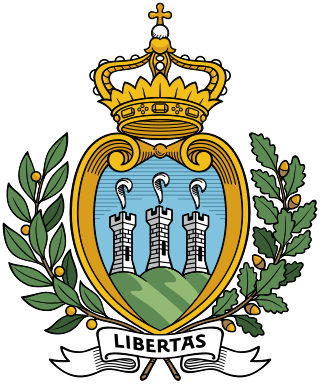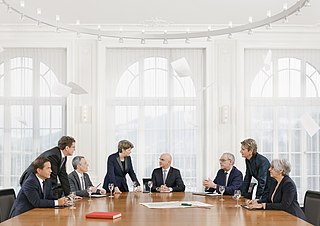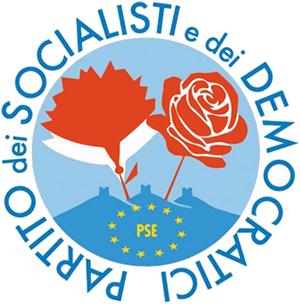
The politics of the state of San Marino take place in a framework of a unitary assembly-independent representative democratic republic, whereby the Captains Regent are the heads of state and heads of government. The country has a multi-party system. Executive power is exercised by the government. Legislative power is vested in both the government and the Grand and General Council. The judiciary is independent of the executive and the legislature.

The Federal Council is the executive body of the federal government of the Swiss Confederation and serves as the collective head of state and government of Switzerland. It meets in the west wing of the Federal Palace in Bern.

The Sammarinese Communist Party was a Marxist political party in the small European republic of San Marino. It was founded in 1921 as a section of the Communist Party of Italy (PCI). The organization existed for its first two decades as an underground political organization.

San Marino elects on the national level a legislature. The Grand and General Council has 60 members, elected for a five-year term by semi-proportional representation with national majority bonus.

The Party of Socialists and Democrats is a social-democratic and democratic socialist political party in San Marino. It is a member of the Socialist International, and observer member of the Party of European Socialists. It is the only Sammarinese party with a reference to the European Union in its official political symbol. Its current-day Italian counterpart is the Democratic Party.

The Grand and General Council is the parliament of San Marino. The council has 60 members elected for a five-year term.
The Arengo was the name of the assembly that ruled San Marino from the fifth century A.D. to 1243, and of the popular councils which regulated the political life in Northern Italy free comuni in the Middle Ages as well. It was made up of the heads of San Marino's Great families and had no leader or fixed meeting place. This made San Marino almost unique in the period as a state that had no Head of State. However this form of rule was cumbersome and the Arengo was crippled by feuds between the Great Families. By the early 13th century the Arengo had become so dysfunctional that the citizens of San Marino decided to elect their own assembly, which they called the Grand and General Council. This assembly became very powerful, and by 1243 the Pope, who was the nominal ruler of San Marino, made the Grand and General Council the supreme body of San Marino.

The Politics of Lombardy, Italy, takes place in a framework of a semi-presidential representative democracy, whereby the President of the Region is the head of government, and of a pluriform multi-party system. Legislative power is vested in the Regional Council of Lombardy, while executive power is exercised by the Regional Government led by the President, who is directly elected by the people. The current Statute, which regulates the functioning of the regional institutions, has been in force since 2008.

The fatti di Rovereta was a constitutional crisis in San Marino in 1957 in which the Grand and General Council was deliberately rendered inquorate to prevent the scheduled election of Captains-Regent. A provisional government was established in the village of Rovereta, in opposition to the outgoing Captains-Regent whose term had expired.

General elections were held in San Marino on 10 June 1906.

General elections were held in San Marino on 19 June 1909 to elect the second term of the Grand and General Council.

General elections were held in San Marino on 13 June 1915 to elect the fourth term of the Grand and General Council.

General elections were held in San Marino on 9 June 1918 to elect the fifth term of the Grand and General Council.

General elections were held in San Marino on 14 November 1920 to elect the sixth term of the Grand and General Council. It was the country's first snap election, and the first election to use a form of proportional representation. The result was a victory for the Sammarinese People's Party, which won 29 of the 60 seats.

General elections were held in San Marino on 4 March 1923 to elect the seventh term of the Grand and General Council. It was a snap election that marked the beginning of fascist rule in the republic. Left-wing parties were prevented from participating, while all centre-right forces ran as a single "Patriotic Bloc". Of the 60 seats, 29 were taken by the Sammarinese Fascist Party, 20 by the Sammarinese People's Party, 9 by the Sammarinese Democratic Union and two by the Fascist-puppets Volunteers of War. Later the country was taken over by the Fascist Party.

General elections were held in San Marino on 7 September 1969. The Sammarinese Christian Democratic Party remained the largest party, winning 27 of the 60 seats in the Grand and General Council, and formed a coalition with the Independent Democratic Socialist Party, together holding 38 of the 60 seats. The Christian Democratic Party had flown in 400 supporters from the United States to vote for them.

The 1906 San Marino citizenry meeting was a session of the Arengo in San Marino. It was the first such meeting in three centuries. It ended oligarchic rule and resulted in the first modern democratic elections in the country.
General elections were held in San Marino on 11 November 2012. The 60 seats in the Grand and General Council were up for grabs. The elections were held using the majority bonus system. The previous election, held in 2008, provided the Sammarinese Christian Democratic Party with the largest single parliamentary group. The Party of Socialists and Democrats, although winning more votes than the former, became the main opposition party.

Democratic Socialist Left was a political party in San Marino, founded as an electoral list for the 2016 general election, including United Left, Progressives and Reformists and Democratic Laboratory. The three parties officially merged into a single party in November 2017. The party was dissolved on 30 December 2020 to merge into with Libera San Marino.

General elections were held in San Marino on 8 December 2019.








